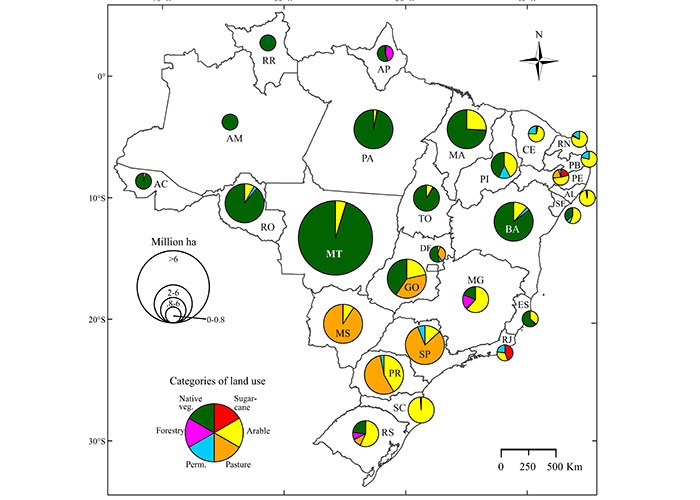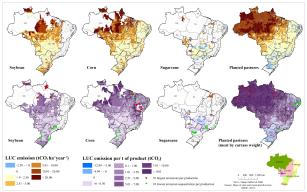Researchers create method to calculate impacts of land use change in Brazil
Researchers create method to calculate impacts of land use change in Brazil
Scientists have just finished the first tool that can consistently estimate the impacts caused by land use change (LUC) for the entire Brazilian territory. Created in partnership between Embrapa and the KTH institute, in Sweden, the BRLUC is a method that can estimate carbon dioxide (CO2) emission rates associated with the 64 crops available in the Brazilian Institute of Geography and Statistics (IBGE)'s database.
Researchers believe that the method should become a fundamental source for national studies on carbon footprints and life cycle assessments (LCAs). Information on land use change are mandatory for such studies; however, calculating it is rather complex. Moreover, such changes usually represent a considerable portion of greenhouse gas emissions in developing countries. That is the case of Brazil. So this increases the importance of a means to provide reliable estimates that consider Brazilian conditions.
There are several international LUC methodologies and estimates for Brazil, but generally they use global data and premises that under-represent the dynamics of Brazilian agriculture. Many do not consider, for instance, the existence of more than a harvest per year and the enormous heterogeneity of the domestic territory. Thus it is common that the results are very distant from reality and do not express the sustainability advances the country implemented.
According to Renan Novaes, an Embrapa Environment analyst and one of the creators of the BRLUC, the methodology was developed following the life cycle logic and is based on international standards. “Basically, the goal of methods in this line of thought is to estimate which types of land use (agriculture, cattle farming, forestry, or native vegetation) have given room for the expansion of a given crop 'X' in the last 20 years. From the percentages of the area lost by each land use, CO2 emissions or sequestrations due to the change were calculated and such change in the carbon balance was attributed to product 'X'”, he details.
Novaes explains that each land use has a different carbon stock, and the analyzed crop presents a CO2 emission or sequestration value per hectare according to the pattern of land use change. That figure is then used to compose the carbon footprint of agricultural products. “The BRLUC method provides this estimate in accordance with international standards while considering Brazil's specificities and using official and more detailed databases”, the specialist underscores.
Moreover, the tool incorporates specificities of tropical agriculture and addresses the scarcity of information on historical land use transitions for each crop. Such information is either unavailable or very dispersed in space and time. “In order to bypass that, we developed minimum and maximum emission scenarios in the last 20 years for each crop. Our results show that such variation can be very large and have enormous impacts on the results, and most international standards do not take this into account”, Novaes explains.
The method, by Renan Novaes, Ricardo Pazianotto, and Marilia Folegatti-Matsuura, from Embrapa Environment; Miguel Brandão, from KTH; Bruno Alves, from Embrapa Agrobiology; and Andre May, from Embrapa Maize and Sorghum, has just been published by Global Change Biology.
A computer script that enables any interested parties to run or customize the method and a spreadsheet of all the results for any given crop or Brazilian state for consultation are also available for free download on a web page.
Some results have recently been presented at a seminar aimed at specialists in the area. The data are already being requested by several institutions that conduct carbon footprint and LCA studies. “Since the calculation of the factor is complex, specialists have to spend a lot of time to obtain such numbers. The method will greatly facilitate this work ” Novaes asserts.
For Matheus Fernandes, from the Center of Sustainability Studies of the Getúlio Vargas Foundation (FGV), the method is of enormous importance for the community, as it is in line with the main international guidelines that approach the subject while simultaneously working with the national database. “By considering the country's characteristics, BRLUC will bring results that are more faithful to the Brazilian reality, and it will increase the reliability of the diagnoses generated through the method,” Fernandes believes. “There are some issues to be improved, nevertheless it is the first step towards the consolidation of a regionalized method”, ponders the specialist.
Otavio Cavalett, from the Brazilian Bioethanol Science and Technology Laboratory (CTBE), also learned about the method and considers it a result of the efforts of important Brazilian environmental professionals. “The tool will be important not only to internalize world discussions concerning the climate impacts of direct and indirect land use changes, but also to propose important methodological changes to better represent the specificities of land use dynamics in Brazilian agriculture”, states Cavalett.
Translation: Mariana Medeiros
Cristina Tordin (MTb 28499/SP)
Embrapa Environment
Press inquiries
meio-ambiente.imprensa@embrapa.br
Phone number: +55 19 3311-2608
Further information on the topic
Citizen Attention Service (SAC)
www.embrapa.br/contact-us/sac/


